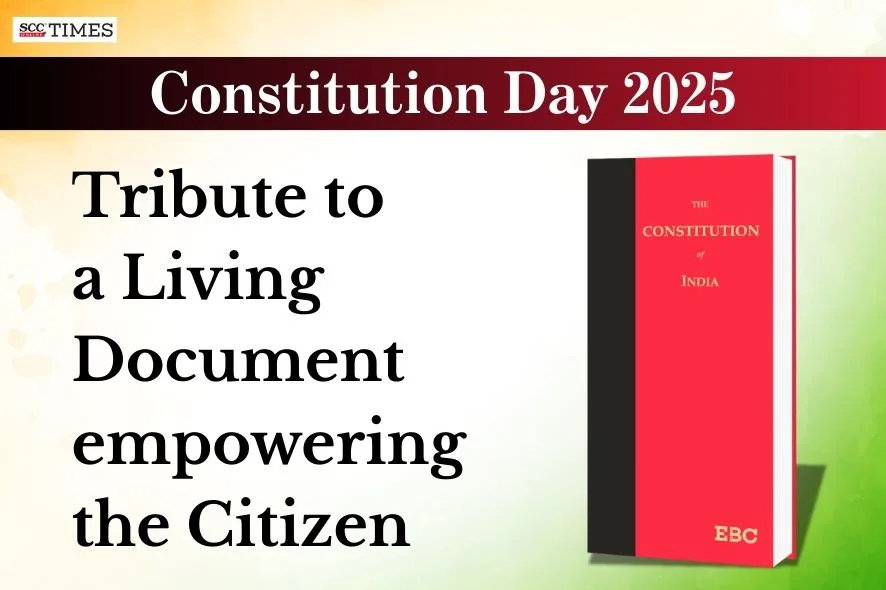On 26th November we celebrate Constitution Day, also known as National Law Day, a day to reflect on India’s transformative journey from independence in 1947. It marks the adoption of the Constitution of India in 1949, a text that guides our nation, ensuring justice, liberty, equality, and fraternity while adapting to the aspirations of each generation.
Constitution Day is not only a commemoration of the past but also a reminder of our ongoing responsibility to uphold its values in the present and future.
Need for a Constitution
As soon as India achieved Independence, there came the monumental task before our leaders to align fragmented states, manage diverse powers, and transform colonial-era laws into a unified framework for free people of an independent country.
To make freedom truly meaningful, India needed a binding document that could define the rights, duties, and institutions essential to securing justice and equality. That framework was the Constitution of India, adopted on 26-11-19491 and brought into force on 26-1-1950.
Making of the Constitution
The journey began in 1946 with the Objectives Resolution, which envisioned a nation founded on justice, equality, and liberty. Later in December2, the Constituent Assembly was formed, bringing together leaders, jurists, and social reformers to draft the Constitution.
On 29-8-1947, Dr. B.R. Ambedkar was appointed Chairman of the Drafting Committee. Over three years of rigorous debate and deliberation, the Assembly crafted a document that would become the cornerstone of India’s democracy.
“We, the People of India” The Preamble serves as the introduction and part of Constitution3, declaring India to be a Sovereign, Socialist, Secular, Democratic Republic and pledging Justice, Liberty, Equality, and Fraternity, with dignity for every individual and unity for the nation.
“Glorious triflet of words—Liberty, Equality and Fraternity from the political slogans of the French Revolution”4
Beginning with the powerful words: “We, the People of India.” This phrase affirms that sovereignty, Pandit Jawaharlal Nehru rightly said:
“Sovereignty belong to the people and rests with the people.”5
By placing citizens at the heart of constitutional authority, the Preamble underscores that democracy derives its legitimacy from their collective will. It transforms independence into empowered citizenship, insisting that rights are not political gifts but solemn commitments the State owes to its people.
Citizens Empowered
The Constitution of India empowers citizens not merely as subjects of law but as active participants in democracy. Article 5 establishes the foundation of citizenship, declaring that anyone domiciled in India at its commencement, and meeting conditions of birth or residence, is recognized as a citizen. This assurance of belonging laid the groundwork for a rights-based democracy where every individual could claim equality and dignity.
Building on this foundation, the Fundamental Rights (Part III) were enshrined to enable citizens to challenge arbitrary power and safeguard the freedoms of speech and expression, assemble, associate, move freely, and profess any religion. They guarantee equality before the law and abolish untouchability through Article 17, thus striking at the heart of entrenched social hierarchies. To ensure these rights are not ornamental but enforceable, the framers provided Article 32 (Supreme Court) and Article 226 (High Courts), giving citizens direct remedies when rights are violated.
Dr. Ambedkar famously said this about Constitutional Remedies (Article 32):
‘If I was asked to name any particular article in this Constitution as the most important—an article without which this Constitution would be a nullity—I could not refer to any other article except this one. It is the very soul of the Constitution and the very heart of it and I am glad that the House has realised its importance.’
Beyond rights, the Directive Principles of State Policy (Part IV) guide the State toward social and economic justice, promoting equitable distribution of resources, worker welfare, and universal education. Though non-justiciable, they gradually convert constitutional promises into lived realities, shaping policy and governance.
Over time, Parliament and the judiciary have expanded this framework of citizen empowerment:
-
Expansion of Article 21 (Right to Life and Personal Liberty) via judicial interpretations has been consistently empowering the citizens to strive for better lives and in turn a progressive nation. The Right to Information Act (2005) operationalized transparency, rooted in Article 19(1)(a), by giving citizens a legal tool to scrutinize public authorities.
-
Environmental rights, read into Article 21 (Right to Life), empowered citizens to demand clean air, water, and sustainable development.
-
Through judicial activism, the judiciary has expanded constitutional guarantees under Part III and through Public Interest Litigation (PILs), a powerful instrument for collective action was devised for public spirited citizens to aid others.
Government Efforts to Empower Citizens
Guided by this citizen centric vision of the Constitution, governments have introduced a range of initiatives to empower citizens socially, legally, and digitally. At the grassroots level, the 73rd and 74th Constitutional Amendments (1992) institutionalized Panchayati Raj and Municipal Governance, devolving power to local bodies and mandating Gram Sabhas, ward committees, and reservations for women and marginalized groups. These reforms transformed governance into a participatory process, ensuring that citizens have a direct voice in decision-making.
Transparency and accountability were strengthened through the Right to Information Act, 2005, which enabled citizens to demand information from public authorities, thereby curbing corruption and reinforcing Article 19(1)(a).
Similarly, Social Audits, mandated under welfare programmes like MGNREGA, empowered communities to monitor and evaluate government schemes, ensuring benefits reach intended beneficiaries. Digital empowerment emerged as a cornerstone of citizen engagement.
The Digital India programme sought to transform India into a digitally empowered society6. Platforms such as MyGov allowed citizens to contribute ideas and participate in policy discussions, while UMANG integrated over 1,000 government services into a single mobile app. DigiLocker was brought in to provide secure digital storage of documents, and Common Services Centres (CSCs) extended these facilities to rural areas, bridging the digital divide. Initiatives like Aadhaar and Direct Benefit Transfer (DBT) streamlined welfare delivery, reducing leakages and ensuring efficiency.
Government empowers citizens through elections led by the independent Election Commission of India (ECI). Universal adult franchise from the gave every citizen an equal voice in shaping government. The 61st Amendment (1988) lowered the voting age to 18, expanding youth participation. Flagship programmes like SVEEP and National Voters’ Day spread voter literacy and pride. Accessibility measures like AMF facilities, postal ballots for seniors/PwDs, Braille EVMs, ensure inclusivity. Digital tools like the Voter Helpline App, NVSP, and social media outreach enhance transparency.
Constitution as Our Pride and Living Document of Democracy
Our Constitution, the world’s longest written charter, is not only a masterpiece of design but a moral achievement that transforms independence into empowered citizenship.
The rights, remedies, principles, duties, and evolving amendments ensure that Indian democracy remains both participatory and ethical, a living Constitution that empowers citizens while adapting to the challenges of each generation.
Social and legal empowerment initiatives reinforce this engagement: campaigns like Hamara Samvidhan, Hamara Samman, schemes such as Stand-Up India and the Nari Shakti Vandan Adhiniyam, and youth programmes like MY Bharat nurture civic responsibility and pride.7
Together, these ideals ensure that the Constitution functions both as an operating manual of governance and a moral compass of citizenhood, guiding India’s democratic journey across generations.
1. http://www.scconline.com/DocumentLink/79Lvxr38
2. http://www.scconline.com/DocumentLink/n0DCLMj1
3. http://www.scconline.com/DocumentLink/Rzq4ziNc
4. http://www.scconline.com/DocumentLink/kJ5h8K99
5. http://www.scconline.com/DocumentLink/tbP5vP10
6. (PDF) Digital India: An analysis of its impact on Economic, Social, and Environmental sectors



